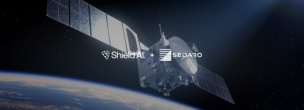Space weather forecasters are predicting more solar storms in the coming year, potentially putting satellites in the crossfire.
Officials from NASA and NOAA announced last month that the Sun has reached its Solar Maximum period, when solar flares and coronal mass ejections (CMEs) become more likely. This means more risk for satellite operators, as solar storms can disrupt communications and increase atmospheric drag, which can drastically reduce a satellite’s lifetime.
A report from Space Foundation last week outlined how NASA, NOAA, and the commercial satellite industry are preparing to weather these storms.
Heating up: Solar storms can launch X-rays, UV radiation, and particles at Earth, causing radio blackouts, GPS interference, and power grid failures.
“This year, during Solar Cycle 25, there is much greater technology to estimate these storms, but much more to lose,” Space Foundation analyst Jeff Gardner said in the report, highlighting the growing investment in space infrastructure.
The collection of scientific instruments monitoring the Sun has grown considerably, and even more solar monitoring sats are planned in the coming years.
- The GOES-19 satellite, which launched in June, brought the first space-based coronagraph to space, according to NOAA. The Compact Coronagraph-1 (CCOR-1) monitors CMEs to predict space weather events on Earth.
- ESA’s solar orbiter, launched in 2020, has come within 42 km of the Sun to determine the roots of the 11-year solar cycle and study how solar winds form.
- The Parker Solar Probe, which launched in 2018, flew through the Sun’s atmosphere for the first time in 2021. The spacecraft will orbit the Sun two dozen times over the next few years in an attempt to determine the origins of solar wind.
- Next year, NOAA is expected to launch the Space Weather Follow-On satellite (SWFO-L1), which will include two more compact coronagraphs and a global ground segment to process data in real-time.
Storm light: Solar Cycle 25, which began in 2019, has already brought many powerful solar storms to Earth’s doorstep. In some cases, the increased solar activity put satellites out of commission years earlier than expected.
In February, SpaceX lost 40 of 49 Starlink satellites a day after they were deployed on orbit due to a geomagnetic storm. In 2023, two Capella Space satellites also fell out of orbit less than two years after launch due to atmospheric density in LEO being 2-3x higher than early NOAA predictions.
For many satellite operators, the best protection against solar activity is to switch their birds into safe mode to ride out the storm and reboot afterwards, according to Gardner.
However, Capella took a more proactive approach. The company changed the way they build, deploy, and operate satellites to extend the lifespans of their birds going forward.
- Capella increased the size of its propulsion systems to offer greater capability to raise their orbits, and increased the mass of one of its satellites to counter atmospheric drag.
- The company’s satellites are now deployed at a higher altitude to avoid denser areas of the atmosphere at the outset of their missions.
- The company also flies its older Whitney satellites that came before these changes in a “low drag mode,” with its solar arrays positioned edge-on to minimize satellites’ drag profile.
“Capella doesn’t have special operating procedures for solar storms or CMEs other than to fly right through them,” Capella’s ADCS and propulsion senior manager Scott Shambaugh told Payload. “Even during the big storms earlier this year that produced spectacular auroras, our spacecraft sailed through with minimal impact to their operations.”
High alert: Even though the peak of this solar cycle may still be over the horizon, the combination of early warning systems and the robust preparations of satellite operators is already paying off.
In May, scientists noticed CMEs and solar flares headed towards Earth, and the resulting storm was the strongest to hit the planet in more than two decades.
The advanced warning gave satellite operators the chance to go into safe mode or raise their orbits to counter the storm. While there were still widespread impacts, including disruptions to GPS, orbital decay, and drag impacting thousands of satellites, no satellites were destroyed during the event.
“That storm in May was the most successfully mitigated extreme space weather storm in history,” said NOAA forecaster Shawn Dahl.
Correction: This article was updated to correct the spelling of Capella.




